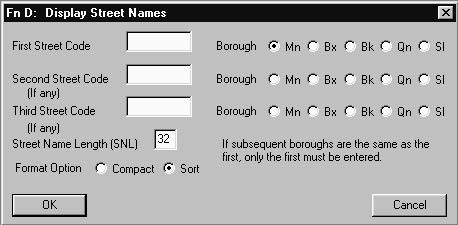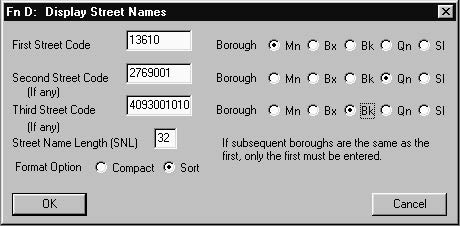XI.11 Invoking Function D
To invoke Function D, you must click on “D” in the tool bar or the “FN D” in the “Goat Function” list. As you can see in the dialogue box displayed to the right, you have the option of supplying up to three street codes at once. You must supply the Borough information for the first street code. You only need supply the borough information for the second and third street code if the borough is different than the first one. The street codes may be entered as 5, 7 or 10 digit street codes.
Any order or
As you can see in the dialogue box displayed to the right, you have the option of supplying up to three street codes at once. You must supply the Borough information for the first street code. You only need supply the borough information for the second and third street code if the borough is different than the first one. The street codes may be entered as 5, 7 or 10 digit street codes.
Any order or  combination is permitted. In the example illustrated to the right, not only is each street code in another borough, but each street code is of a different length; the first one is five digits, the second is seven and the third is ten.
combination is permitted. In the example illustrated to the right, not only is each street code in another borough, but each street code is of a different length; the first one is five digits, the second is seven and the third is ten.
You may also influence the output by modifying the contents of the text box next to the label “Street Name Length (SNL)”. Leaving the SNL at 32 results in the output illustrated below.

However reducing the SNL value to 14, results in the output below where the word “STREET” is abbreviated to “ST” and “AVENUE” is abbreviated to “AVE”.

The second method that you may use to influence the output of Function D using GOAT is the Format Option. The choices are “Compact” and “Sort”. This option affects the format of street names that contain numbers. “Sort” is the default and causes blanks to be inserted in a street name in front of the number. Notice the extra blanks in front of the number 34 in the above output. If instead of leaving the Format Option set to “Sort”, you select “Compact”, the extra blanks in front of '34' will be removed as illustrated in the output below.

Notice also that the “Compact” option has no effect on the display of the street names that include only non-numeric words.